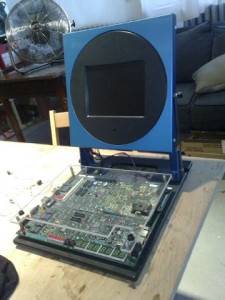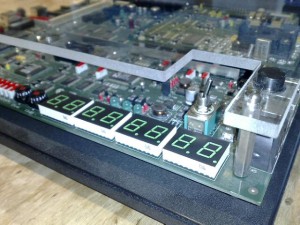Help me ID this device!
Uncategorized
Add comments
Aug 012008
Query: what the hell is this thing I’ve been lugging around for the past three years?
It’s some sort of StrongARM development system. I think it may be related to the Intel “Brutus” eval boards, but I’m not certain. The daughterboard is labelled “SA1110 daughter card”; there’s nothing useful on the larger board. There’s a fairly anonymous StrongARM chip in the ZIF socket. It feels like some sort of demo unit, given how it’s all gussied up and under acrylic.
What’s on the big board?
- one USB client port
- three USB host ports
- two classic RS232 ports
- nine general-purpose indicator LEDs
- eight general-purpose switches
- two four-bit rotary switches
- eight seven-segment w/ decimal LED displays
- six audio jacks
- a CF slot
- a PCMCIA slot
- and innumerable spare headers, LEDs, switches, etc.
Intel sold off all its StrongARM/PXA properties years ago, and scrubbed pretty much anything useful from its website. Archive.org hasn’t been too helpful. Anyone have any leads?
20 Responses to “Help me ID this device!”
Comments (20)


The SA1110 dauhterboard housed a processor for use in PDAs and smartphones. It was designed in 1999 and used in products built 2001-2003
Basic specs, with a link at bottom to a product list:
http://smartphonedb.com/index.php?m=cpu&id=a1110
I found this by using a bog standard Japanese translation tool. As late as 2000, it looks like Intel was using this daughterboard to test next generation mobile processors. So perhaps this funky object is designed to test the capabilities, performance, and power function of a processor at various frequencies?
Wacky Japanese translation of Fall 2000 developer news:
http://translate.google.com/translate?hl=en&sl=ja&u=http://ascii24.com/news/i/tech/article/2002/02/12/633516-000.html&sa=X&oi=translate&resnum=1&ct=result&prev=/search%3Fq%3DStrongARM/PXA%26hl%3Den%26rls%3Dcom.microsoft:en-us:IE-SearchBox%26rlz%3D1I7DGUS
This is a giant CMOS clock/counter. Reminds me of some railroad systems Ive seen.
That looks a helluva lot like the early prototype development board for an Apple Newton. It’s a lot of work and expense to cram an LCD, a touchscreen, battery, ROM, and all the various electronics into an elegant package one can carry around, so you don’t do that until the timing is right and you’re pretty sure the software is going to work and the hardware you’ve chosen will provide all the capabilities you need. So a lot of the software development was done on big boards like that. You plugged that board into a Mac running A/UX (or whatever they called that gawdawful Unix variant that ran on pre-OSX macs) and there were programs one could use to download new ROM images and debug what was going on once you used the thing.
Incidentally, I had one of those monstrosities on my desk at Apple. Where did you get yours?
The StrongARM chip was used in the Newton MessagePad 2000 and in the 2100 (both released in 1997).
Hi Glen;
Mine was a gift from a friend circa 2002 or so. He picked it up somewhere in Austin. He didn’t have and idea what it was, but figured it looked like something I’d enjoy.
The fact that it was from Texas, and the distinctive color of the bezel, always led me to assume it was an Intel product, but now that I think about it, the fancy styling of the case is very Apple.
I opened up the rom carriers and a couple of the flash chips are hand-labeled “linux”, I’m guessing there’s something redboot-ish on there as well. I’ll try to get around to powering this thing up sometime this week and see what I can get chugging.
He probably got it at Goodwill Computer Works in Austin Texas. They have many oddities there, check out their vintage/rare museum if you are ever in town.
http://www.austincomputerworks.org/index.html
Looks like the dev boards for PalmOS 5. I remember seeing a video of a graph being rendered in real time and they compared the speed between a PalmOS 4 device to this device running 5.
Then again, I could be wrong. Its monday where I am 😉
It’s a PXA250 and PXA255 development board. Codenamed Lubbock. If you indeed have a SA1110 card, then you have a special version. The SA1110 cards were made to validate the board before the PXA250 chips were available.
The system was designed by the XScale group at Intel Austin with software development in Massachusetts and distributed internal teams, potential customers, and OS partners.
If you can get a PXA255 or PXA250 CPU board for it, you may be able to find schematics and software around the net. The XScale JTAG solutions are quite expensive but there was a simple parallel port solution and a free tool called jflash that could program the flash on Lubbock systems.
BUT, and this is a bit “BUT,” these systems get less reliable as they age because of all the connectors. If you want to do some hacking on a fast ARM compatible system, picking up something like a Gumstix will be much more reliable for you. From the Lubbock system, you can probably salvage the power supply, and the LCD.
Have Fun.
The Newton used an SA110, not the SA1110, and it never had USB. This also looks remarkably like the Brutus board. And it doesn’t really feel apple-y enough. I would be very surprised if it had anything to do with the Newton. More likely it’s for one of the many funky pseudo-PDA machines, web terminals, etc that showed up around the turn of the century.
If it was a demo unit, it probably would have logos on it.
Have you tried turning it one and posting a picture?????
It cannot be a Newton devel board. Newton was developed and sold around 1993. This board has USB ports – USB came to be only around 1996. Also the SA1110 CPU was used in things like Jornada or iPaqs, Newton predates that by a good deal.
So it is something more modern – the first commenter can be spot on.
It’s not a Newton, at least not with USB on board.
Its just a SA1110 dev board. Intel made several StrongARM dev boards for SA1110, PXA255 and PXA27x in that same form factor. I have a PXA27x version sitting around and I have worked with the SA1110 and PXA255 version as well.
Hi Phooky,
Anyway, can I get to see this in person?
Love to take a few shots of my own and place it up on my Flickr site if you’d allow it.
I’m into Newtons and would appreciate it if it were possible. Especially since it’s a Newton 😀 I’m in the NYC area in case.
I don’t think it’s a Newton dev board, as you wouldn’t see a usb port on one of those. It does look like some sort of dev board, though…
the Newton didn’t have USB. Pretty sure USb wasn’t even close to standardized when the Newton was being developed.
This board has USB Host and Client ports. Ergo, not a Newton.
I did a little more research into the different flavors of Newton boards. The most common Newton prototype in a similar format was called a Bun Warmer but that had the display flat on the board with an identifiable area for the silkscreen buttons. Despite being a big sprawling board, it had identifiably Newton-like elements.
I believe Jim is correct that this thing was a “Lubbock”. A testbed for StrongARM and similar chips. We did use some Lubbock boards at Apple while developing the later Newton models (circa 1997), but yours is a more recent version than the one I saw. Due to – as noted – both the USB and the SA1110.
Looks pretty same:
http://www.koansoftware.com/en/prd_wince.htm
Wow, thanks for all your replies! It does indeed look like a Lubbock dev board. Work and out-of-town guests are keeping me pretty busy, but I’ll see if I can try to power this sucker up by the end of the week.